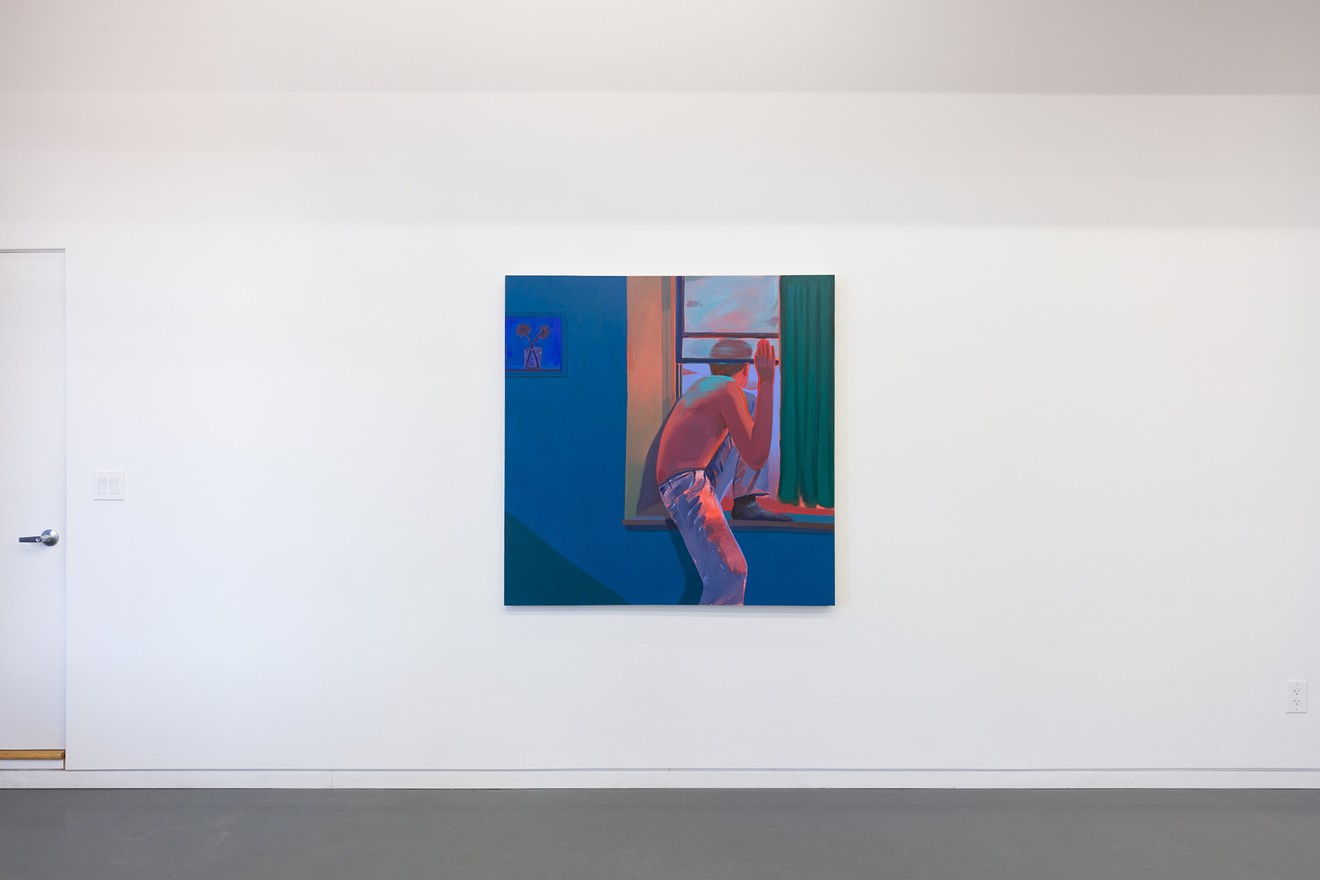Caleb Hahne emerged on the Denver scene a half-dozen years ago, just as he completed his BFA at the Rocky Mountain College of Art + Design in 2014. His work took off immediately, and he's exhibited pieces not only here, but in Los Angeles, New York, Montreal, Berlin and the United Kingdom.
In the One Sun paintings, Hahne continues exploring his own identity through memories of his childhood. The figures, all young males, are mostly depicted from behind or from the side, so that their faces have been somewhat obscured. The poses they take are imaginative, and are used to carry forward the narrative. There's an implicit story of a kid sneaking out of the house in one of the few large-ish paintings, "Window (New York)." The body, seen from the rear, is in a contrapposto position, with one leg on the sill and the other hanging down the wall as he turns his body to make his escape.
Hahne’s drafting of the human form in characterful stances has a lyric quality and lends his paintings a kind of elegance. His brushwork is extremely confident and fairly bold, especially considering the representational imagery he’s conveying, without sacrificing any details: Our mind’s eye fills in what’s missing. In “Morning Sun,” for example, a guy’s head is seen from the back, his fingers gripping the back of his neck. He's looking at the sunrise, which is represented by the pinkish-orangey field that surrounds him. In this painting, as in many others, Hahne juggles hot and cold shades, often versions of that pink-and-orange combination, using them for both skin and skies, set against different shades of strong, clear blue. This creates strong contrasts between parts of the compositions, which Hahne exploits to great effect.

Caleb Hahne acrylic-on-canvas paintings (left to right) "Pier," "Night Walk" and “Self Portrait with Bluets (Cheesman Park).”
Wes Magyar
While all of the One Sun paintings function as a body of work, a couple are clearly different from the rest, with a magical or dream-like mood. One is “Fountain,” a vaporous image of an outstretched arm carried out in a color only slightly different from the background; the other is “Night Walk,” where the crossed feet that anchor it stand out from the ground.
Markedly different concerns are at play in the two overlapping shows at the William Havu Gallery. On the walls comprised by the warren of rooms on the first floor are dozens of paintings and works on paper that make up the duet New Worlds: Lui Ferreyra; Ryan Magyar. Dotting the floor between those walls are the sculptures of Formal Inflations: Emmett Culligan. Because of the way the space is divided, each of the painters occupies his own separate space, with the sculptures unifying the show.
Inside the door and at the bottom and side of the staircase are paintings by Lui Ferreyra. He takes an interesting route to representational imagery, fracturing his subjects into small shapes, each in its own color. The effect is kind of like a paint-by-numbers picture in which areas of colors are combined to suggest particular tones, spatial depth and recognizable things.
Sometimes, as in “Life After Death,” the results are fairly realistic. In the center is a human skull, a pair of hands covering its eye sockets. The bright white skull and shiny pink hands set against a dark background of flowers reads from a distance like a traditionally painted illustration, but up close the discrete chunks of color atomize the various elements of the scene. Other paintings are clearly aggregations of bits of color, like the hallucinogenic landscapes “Concrescence” and “Portal.” In these, the tinted bits predominate, making the works all but abstract, so they don’t look realistic at all. These two landscapes are standouts in a very strong group.

Installation view of Ryan Magyar oil-on-linen paintings.
Nick Ryan, courtesy of William Havu Gallery
The forms in the Brooklyn Magyar’s pieces are irregularly shaped, with flowing and meandering rather than straight lines. The paintings have been built up in layers, with Magyar adding pigment both before and after the lower levels have dried. The forms have complex margins, like the coastlines on a map, but like maps, they also have hard edges. Examining the joints between the colored forms, you can discern the separate layers revealed in the suggested cliffs and valleys that lie between them.
Both the Ferreyra and Magyar paintings resonate beautifully with the handful of sculptures by Emmett Culligan. In recent years, Culligan has created distinctive sculptures by welding steel plates into shapes, like solid rectangles or soft organic forms. He then heats them in a furnace so the metal becomes somewhat malleable, and pumps in compressed air, which causes the sides of the various elements to push out like pillows. The results are stunning.

Emmett Culligan's steel-and-marble sculpture "Rubric 1B," with Ryan Magyar paintings in the background.
Nick Ryan, courtesy of William Havu Gallery
While these Havu shows are larger than the Rule solo, they're all playing well out of their league...and the results are winning.
Caleb Hahne: One Sun, through February 8, Rule Gallery, 808 Santa Fe Drive, 303-800-6776, rulegallery.com.
New Worlds: Lui Ferreyra; Ryan Magyar and Formal Inflations: Emmett Culligan, through February 29, William Havu Gallery, 1040 Cherokee Street, 303-893-2360, williamhavugallery.com.












